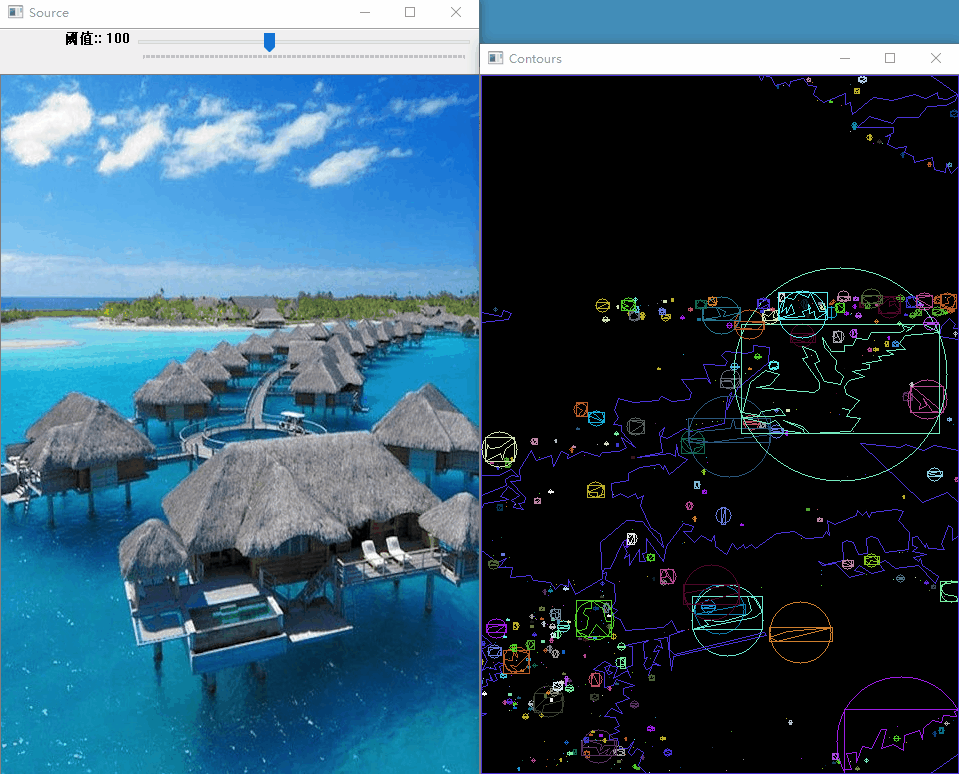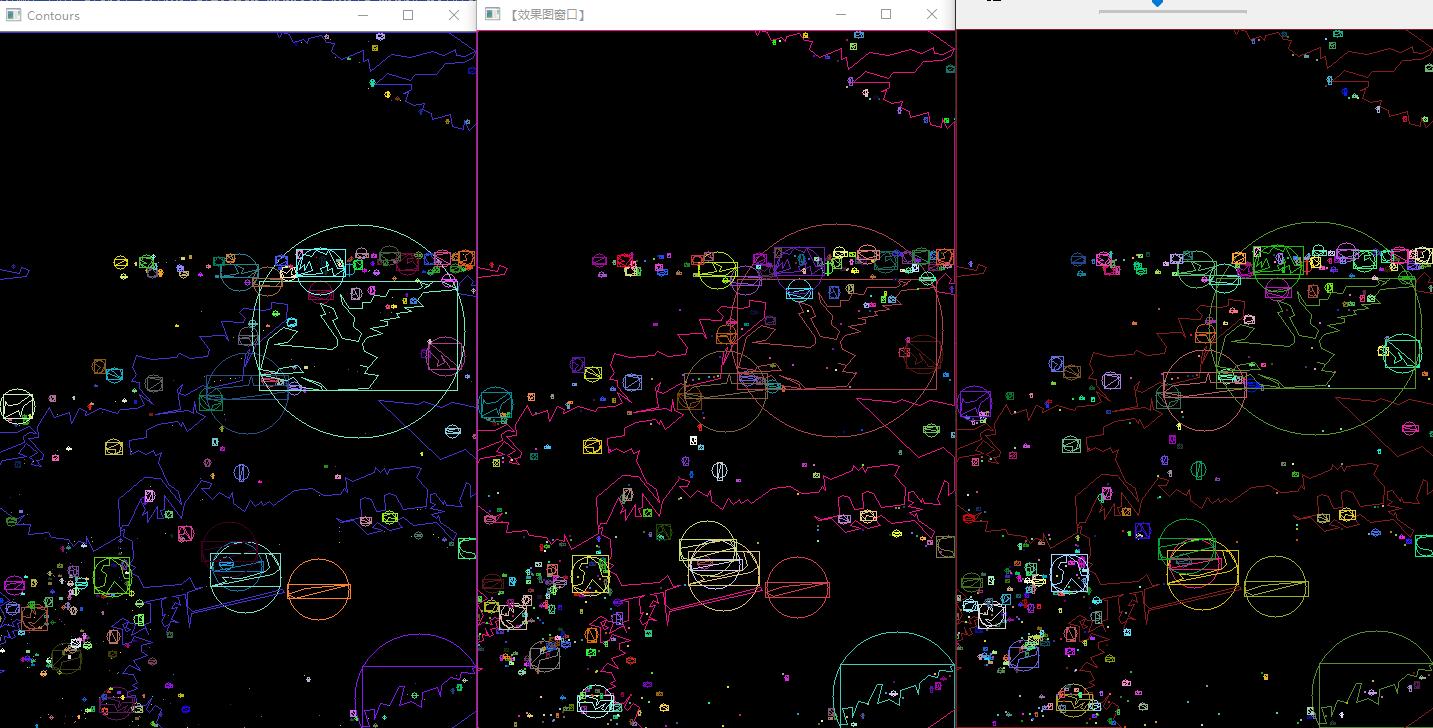创建包围轮廓的矩形和圆形边界框
视频讲解如下:
在上一节中,给大家演示了轮廓的最小圆形检测,在本章节中给大家演示一个矩形和圆形识别的综合示例,当前代码同样的是在毛星云的代码基础上进行扩展优化的。
C#、C++、Python三种版本的效果其实是一样的,我这里就拿C#的版本来做个演示。
当前系列所有demo下载地址:
https://github.com/GaoRenBao/OpenCv4-Demo
不同编程语言对应的OpenCv版本以及开发环境信息如下:
语言 | OpenCv版本 | IDE |
C# | OpenCvSharp4.4.8.0.20230708 | Visual Studio 2022 |
C++ | OpenCv-4.5.5-vc14_vc15 | Visual Studio 2022 |
Python | OpenCv-Python (4.6.0.66) | PyCharm Community Edition 2022.1.3 |
首先呢,我们需要准备一张测试图片。(不想下载工程的童鞋,可直接复制下面的图片和代码)

演示效果如下:

三个版本的演示对比效果如下,从左到右分别是:C#、C++、Python,阈值设置都是100.

C#版本代码如下:
C#版本需要安装“OpenCvSharp4”、“OpenCvSharp4.runtime.win”两个库才行。不然会报错。
如果需要使用“ BitmapConverter.ToBitmap”操作,则需要追加安装“OpenCvSharp4.Extensions”库。
using OpenCvSharp;
using System;
namespace demo
{
internal class Program
{
static Mat g_grayImage = new Mat();
static int thresh = 100;
static RNG rng = new RNG(12345);
static void Main(string[] args)
{
// 【1】读取图像
Mat src = Cv2.ImRead("../../../images/home2.jpg");
if (src.Empty())
{
Console.WriteLine("Could not open or find the image!");
return;
}
//【2】得到原图的灰度图像并进行平滑
Cv2.CvtColor(src, g_grayImage, ColorConversionCodes.BGR2GRAY);
Cv2.Blur(g_grayImage, g_grayImage, new Size(3, 3));
//【3】创建原始图窗口并显示
Cv2.NamedWindow("Source", WindowFlags.AutoSize);
Cv2.ImShow("Source", src);
//【4】设置滚动条并调用一次回调函数
Cv2.CreateTrackbar("阈值:", "Source", ref thresh, 255, thresh_callback);
thresh_callback(0, IntPtr.Zero);
Cv2.WaitKey();
}
private static void thresh_callback(int pos, IntPtr userData)
{
Mat threshold_output = new Mat();
// 使用Threshold检测图像边缘
Cv2.Threshold(g_grayImage, threshold_output, thresh, 255, ThresholdTypes.Binary);
// 找出轮廓
Point[][] contours;
HierarchyIndex[] hierarchy;
Cv2.FindContours(threshold_output, out contours, out hierarchy, RetrievalModes.Tree, ContourApproximationModes.ApproxSimple);
// 多边形逼近轮廓 + 获取矩形和圆形边界框
Point[][] contours_poly = new Point[contours.Length][];
Rect[] boundRect = new Rect[contours.Length];
Point2f[] center = new Point2f[contours.Length];
float[] radius = new float[contours.Length];
// 一个循环,遍历所有部分,进行本程序最核心的操作
for (int i = 0; i < contours.Length; i++)
{
// 用指定精度逼近多边形曲线
contours_poly[i] = Cv2.ApproxPolyDP(contours[i], 3, true);
// 计算点集的最外面(up-right)矩形边界
boundRect[i] = Cv2.BoundingRect(contours_poly[i]);
// 对给定的 2D点集,寻找最小面积的包围圆形
Cv2.MinEnclosingCircle(contours_poly[i], out center[i], out radius[i]);
}
// 绘制多边形轮廓 + 包围的矩形框 + 圆形框
Mat drawing = Mat.Zeros(threshold_output.Size(), MatType.CV_8UC3);
for (int i = 0; i < contours.Length; i++)
{
//随机设置颜色
Scalar color = new Scalar(rng.Uniform(0, 255), rng.Uniform(0, 255), rng.Uniform(0, 255));
//绘制轮廓
Cv2.DrawContours(drawing, contours_poly, (int)i, color);
//绘制矩形
Cv2.Rectangle(drawing, boundRect[i].TopLeft, boundRect[i].BottomRight, color, 1);
//绘制圆
Cv2.Circle(drawing, new Point(center[i].X, center[i].Y), (int)radius[i], color, 1);
}
Cv2.ImShow("Contours", drawing);
}
}
}
C++版本代码如下:
#include "opencv2/highgui/highgui.hpp"
#include "opencv2/imgproc/imgproc.hpp"
using namespace cv;
using namespace std;
#define WINDOW_NAME1 "【原始图窗口】" //为窗口标题定义的宏
#define WINDOW_NAME2 "【效果图窗口】" //为窗口标题定义的宏
Mat g_srcImage;
Mat g_grayImage;
int g_nThresh = 100;//阈值
int g_nMaxThresh = 255;//阈值最大值
RNG g_rng(12345);//随机数生成器
void on_ContoursChange(int, void*)
{
//定义一些参数
Mat threshold_output;
vector<vector<Point>> contours;
vector<Vec4i> hierarchy;
// 使用Threshold检测边缘
threshold(g_grayImage, threshold_output, g_nThresh, 255, THRESH_BINARY);
// 找出轮廓
findContours(threshold_output, contours, hierarchy, RETR_TREE, CHAIN_APPROX_SIMPLE, Point(0, 0));
// 多边形逼近轮廓 + 获取矩形和圆形边界框
vector<vector<Point> > contours_poly(contours.size());
vector<Rect> boundRect(contours.size());
vector<Point2f>center(contours.size());
vector<float>radius(contours.size());
//一个循环,遍历所有部分,进行本程序最核心的操作
for (unsigned int i = 0; i < contours.size(); i++)
{
//用指定精度逼近多边形曲线
approxPolyDP(Mat(contours[i]), contours_poly[i], 3, true);
// 计算点集的最外面(up-right)矩形边界
boundRect[i] = boundingRect(Mat(contours_poly[i]));
// 对给定的 2D点集,寻找最小面积的包围圆形
minEnclosingCircle(contours_poly[i], center[i], radius[i]);
}
// 绘制多边形轮廓 + 包围的矩形框 + 圆形框
Mat drawing = Mat::zeros(threshold_output.size(), CV_8UC3);
for (int unsigned i = 0; i < contours.size(); i++)
{
//随机设置颜色
Scalar color = Scalar(g_rng.uniform(0, 255), g_rng.uniform(0, 255), g_rng.uniform(0, 255));
//绘制轮廓
drawContours(drawing, contours_poly, i, color, 1, 8, vector<Vec4i>(), 0, Point());
//绘制矩形
rectangle(drawing, boundRect[i].tl(), boundRect[i].br(), color, 1, 8, 0);
//绘制圆
circle(drawing, center[i], (int)radius[i], color, 1, 8, 0);
}
// 显示效果图窗口
namedWindow(WINDOW_NAME2, WINDOW_AUTOSIZE);
imshow(WINDOW_NAME2, drawing);
}
int main()
{
//【0】改变console字体颜色
system("color 1F");
//【1】载入3通道的原图像
g_srcImage = imread("../images/home2.jpg", 1);
if (!g_srcImage.data) { printf("读取图片错误,请确定目录下是否有imread函数指定的图片存在~! \n"); return false; }
//【2】得到原图的灰度图像并进行平滑
cvtColor(g_srcImage, g_grayImage, COLOR_BGR2GRAY);
blur(g_grayImage, g_grayImage, Size(3, 3));
//【3】创建原始图窗口并显示
namedWindow(WINDOW_NAME1, WINDOW_AUTOSIZE);
imshow(WINDOW_NAME1, g_srcImage);
//【4】设置滚动条并调用一次回调函数
createTrackbar("阈值:", WINDOW_NAME1, &g_nThresh, g_nMaxThresh, on_ContoursChange);
on_ContoursChange(0, 0);
waitKey(0);
return(0);
}
Python版本代码如下:
import cv2
import numpy as np
import random
g_nThresh = 100
def on_ThreshChange(x):
global g_nThresh, g_grayImage, drawing
# 获取滑动条的值
g_nThresh = cv2.getTrackbarPos('g_nThresh', 'drawing')
# 二值化
ret, threshold_output = cv2.threshold(g_grayImage, g_nThresh, 255, cv2.THRESH_BINARY)
# 寻找图像轮廓
contours, hierarchy = cv2.findContours(threshold_output, cv2.RETR_TREE, cv2.CHAIN_APPROX_SIMPLE)
# 初始化一个空白图像
drawing = np.zeros((g_grayImage.shape[0], g_grayImage.shape[1], 3), np.uint8)
# 一个循环,遍历所有部分,进行本程序最核心的操作
for i in range(len(contours)):
# 随机设置颜色
color = (random.randint(0, 255), random.randint(0, 255), random.randint(0, 255))
# 用指定精度逼近多边形曲线
contours_poly = cv2.approxPolyDP(contours[i], 3, True)
# 绘制轮廓
cv2.polylines(drawing, [contours_poly], True, color, 1, 8)
# 计算点集的最外面(up-right)矩形边界
x, y, w, h = cv2.boundingRect(contours_poly)
# 绘制矩形
cv2.rectangle(drawing, (x, y), (x + w, y + h), color, 1, 8, 0)
# 对给定的 2D 点集,寻找最小面积的包围圆形
(x, y), radius = cv2.minEnclosingCircle(contours_poly)
center = (int(x), int(y))
# 绘制圆
cv2.circle(drawing, center, int(radius), color, 1, 8, 0)
# 载入3通道的原图像
g_srcImage = cv2.imread("../images/home2.jpg")
# 得到原图的灰度图像并进行平滑
g_grayImage = cv2.cvtColor(g_srcImage, cv2.COLOR_BGR2GRAY)
# 均值滤波
g_grayImage = cv2.blur(g_grayImage, (3, 3))
cv2.imshow("g_srcImage", g_srcImage)
# 初始化一个空白图像
drawing = np.zeros((g_grayImage.shape[0], g_grayImage.shape[1], 3), np.uint8)
# 创建窗口
cv2.namedWindow('drawing')
cv2.createTrackbar('g_nThresh', 'drawing', 0, 255, on_ThreshChange)
cv2.setTrackbarPos('g_nThresh', 'drawing', 100)
while True:
cv2.imshow("drawing", drawing)
if cv2.waitKey(10) == ord('q'):
break
cv2.destroyAllWindows()






